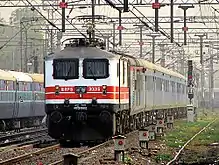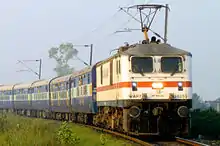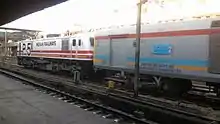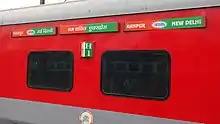Express trains in India
Express trains are express rail services of India. Express trains make a small number of stops, unlike ordinary passenger or local trains. Because of their limited stops, these trains are able to obtain the highest speeds of any trains in India. An express train is one where the average speed, excluding halts, is greater than 42 km/h. This is pretty slow for a train. Including halts the speed may sometimes fall into the region of around 20 km/h for express trains. In some cases, trains run express where there is overlapping local train service available, and run local at the tail ends of the line, where there is no supplemental local service.


Superfast Express
Superfast Express trains are express trains which make still fewer stops, as compared to ordinary express trains, achieving still shorter journey times. Tickets cost more than ordinary express trains as they have "superfast surcharge" added to them. Trains with an average speed, excluding halts, equaling or exceeding 55 kilometres per hour (34 mph) (60 kilometres per hour (37 mph) until the early 1990s) on both up and down journeys fall into this category and are numbered with a prefix of 12 or 22 or 20 (previously 2). Including halts the average speed often is below 55 km/h. In some cases, trains run superfast where there is an overlapping express service available, and run regular express trains where there is no supplementary express service.
As of 2015, 450 pairs of superfast trains ran on the Indian Railways. The 12394/Sampoorna Kranti Express (RJPB/Rajender Nagar Terminal–Ndls/New Delhi) is the fastest non-Shatabdi, non-Rajdhani train in India.
Mail
Mail trains are trains which earlier exclusively had mail coaches. Nowadays, all the trains in the country including mail trains carry mail in luggage coach itself, but the train branding remains in use.
Locomotives
.jpg.webp)
The trains are hauled by most-powerful locomotives in the country, such as WDP-4D or WAP-7, each with an output of more than 4,000 hp.
Coaches
.JPG.webp)
The coaches in these trains are of crash-worthy design from Alstom-LHB, built by Rail Coach Factory, Kapurthala.[2][3] These Alstom-LHB coaches can be pulled to a speed of 160 km/h without any modification.[4] New express coaches are made partly or completely of stainless steel, primarily motivated by lower maintenance, and higher availability. Stainless steel construction also reduces empty weight, enabling more passengers per coach.[5] The bogies, design from Fiat, have two disk brakes per axle[4] essential for safe operations especially at the speed of fast-express trains.
Tracks
The trains run on nationwide Indian gauge. They run on tracks with classifications Group A, permitting speed up to 160 km/h, and Group B for speed up to 130 km/h. Lower speed limits apply when they are on tracks or railway switches, which have lower speed limits. The design of the railway switches, with a speed limit of 50–90 km/h, is the major bottleneck to higher speed.[6] Another constraint is the need to accommodate freight trains at the current top speed of 70 km/h.[7] These constraints to speed are consequences of sharing tracks with freight and lower speed suburban passenger trains.
Stops
Train stops reduce the average running speed of a train by preventing it from gaining higher speed. The distance between stops is as short as 2 km between New Bongaigaon-Bongaigaon on the Howrah–Dibrugarh Kamrup Express, and as long as 528 km between Vadodara–Kota on the Thiruvananthapuram Rajdhani Express.
Un-reserved travel
Indian railways run non-reserved trains under the brand Jan Sadharan Express and Antyodaya Express. These trains have all Unreserved/General coaches.[8]
Apart from Antyodaya and Jan Sadharan trains, unreserved/general coaches are also present in express trains. A new series of Deen Dayalu coaches has also been proposed for long-distance trains. The Deen Dayalu coaches will be more comfortable than the existing old coaches.[9]
Speed
The average speed of trains, range from 36 kilometres per hour (22 mph) to 113 kilometres per hour (70 mph). Of this, counting up and down trains separately, 23 trains have an average speed more than 80 km/h, whereas 72 trains have an average speed between 70 and 80 km/h. The speed of express trains is calculated from the latest Indian Railways timetable.
| Train category | Train name | Max. speed | Avg. speed | Notes |
|---|---|---|---|---|
| Gatimaan Express | Jhansi Gatimaan Express | 160 km/h | 113 km/h* | the fastest train in India according to operational speeds |
| Vande Bharat Express | Varanasi Vande Bharat Express | 130 km/h[10] | 96.8 km/h | the fastest train in India as per capability |
| Rajdhani Express | Bandra Rajdhani Express | 150 km/h | 97.8 km/h | fastest Rajdhani express |
| Shatabdi Express | Habibganj–New Delhi Shatabdi Express | 150 km/h | 89 km/h |
|
| Duronto Express | Sealdah–Bikaner Duronto Express | 135 km/h | 85 km/h |
|
| Rajdhani Express | Mumbai Rajdhani Express | 130 km/h | 91.3 km/h | second fastest Rajdhani express between Mumbai and Delhi after Bandra Rajdhani Express |
| Vande Bharat Express | New Delhi Shri Mata Vaishnov Devi Katra Vande Bharat Express | 130 km/h | 81.8 km/h | second train of Vande Bharat Express series |
| Tejas Express | Mumbai CSMT Karmali Tejas Express | 130 km/h | 66.8 km/h | first Tejas express of India |
| Tejas Express | Lucknow Jn New Delhi Tejas Express | 130 km/h | 83 km/h | fastest Tejas express. Operated by Private (IRCTC) |
| Tejas Express | Chennai Egmore Madurai Tejas Express | 130 km/h | 78 km/h | first Tejas express of South India |
| Tejas Express | Ahmedabad Mumbai Central Tejas Express | 130 km/h | 78 km/h | Third dedicated premium train between Mumbai to Ahmedabad |
| Rajdhani Express | Howrah Rajdhani Express | 130 km/h | 85 km/h | fifth-fastest train in India |
| Shatabdi Express | Howrah–Ranchi Shatabdi Express | 130 km/h | 74 km/h | sixth-fastest train in India |
| Suvidha Superfast Express | Patna–Mumbai CST Suvidha Superfast Express | 110 km/h | 63 km/h | fastest among Suvidha Expresses |
| Yuva Express | Howrah–Anand Vihar Yuva Express | 130 km/h | 82 km/h | fastest Yuva Expresses |
| Garib Rath Express | Bandra Terminus–Hazrat Nizamuddin Garib Rath Express | 130 km/h | 82 km/h | fastest among Garib Rath Expresses |
| Duronto Express | Mumbai Central Rajkot Duronto Express | 120 km/h | 76 km/h | Runs non stop from Mumbai to Ahmedabad |
| Jan Shatabdi Express | Kota–Hazrat Nizamuddin Jan Shatabdi Express | 110 km/h | 71 km/h | fastest among Jan Shatabdi Expresses |
| Sampark Kranti Express | Maharashtra Sampark Kranti Express | 110 km/h | 69 km/h |
|
| Double Decker Express | Mumbai Central–Ahmedabad Double Decker Express | 130 km/h | 69 km/h | fastest Double Decker Express |
| AC Express | Lokmanya Tilak Terminus–Hazrat Nizamuddin AC Express | 120 km/h | 76 km/h | fastest AC Express |
| State Express | Visakhapatnam - New Delhi AP Express | 130 km/h | 76 km/h | fastest State Express train |
| VIP Superfast Express | VVIP Shram Shakti Express | 110 km/h | 67 km/h | Non-stop Night Rider of NCR, VVIP Midnight Queen, Superfast. |
| Express | KSR Bengaluru–Nagercoil Express | 100 km/h | 45 km/h | An ordinary Express train |
Gallery
 13351 Bokaro Express
13351 Bokaro Express 18237 Chhattisgarh Express
18237 Chhattisgarh Express A WAP 5 hauled Gatimaan express
A WAP 5 hauled Gatimaan express.jpg.webp) Humsafar Express
Humsafar Express.jpg.webp) Hyderabad - Jaipur Express
Hyderabad - Jaipur Express Mastyagandha Express
Mastyagandha Express 12451/52 VVIP Shram Shakti Express
12451/52 VVIP Shram Shakti Express
References
- Chauhan, Arvind (6 June 2015). "India's fastest train completes final test run in record time". The Times of India.
- Verma, Lalmani (25 January 2010). "To make fast-express trains safe, new design of coach on anvil". The Indian Express. Retrieved 11 March 2013.
- "Rlys may raise stainless steel coach production". BusinessLine. 22 June 2007.
- "Synopsis of Papers Presented in Seminar on 'LHB Coach and New Manufacturing Technologies' Held at RCF, Kapurthala on 4th and 5th November 2003" (PDF). Archived from the original (PDF) on 4 July 2011.
- Gopal, Ramesh R. "Stainless Steel in Rail Transportation: The Scenario in India" (PDF). Indian Stainless Steel Development Association. Retrieved 11 March 2013.
- "High Speed – T.R.Natarajan, Indian Railways". Indian Railway Catering and Tourism Corporation. Archived from the original on 5 March 2016.
- Government of India Ministry of Railways (Railway Board) (December 2009). "Indian Railways 2020 Vision" (PDF).
- "Routes and Timetables of New Tejas, Uday, Humsafar and Antyodaya Trains". 24 Coaches. 29 September 2016.
- "Deen Dayalu coaches: Indian Railways' swanky new offerings for general class". The Economic Times. 26 July 2016.
- 22436/New Delhi - Varanasi Vande Bharat Express